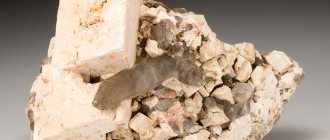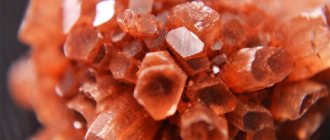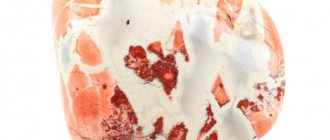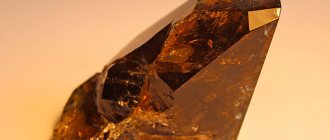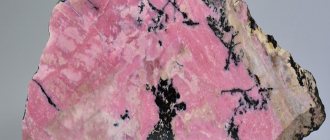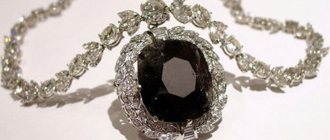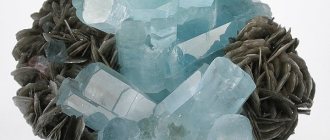Everyone has long known the craving of women for various types of jewelry. Especially from precious and semi-precious materials. Some people like gold and diamonds, some like silver, some women prefer products made from colored stones. The latter include siderite, a mineral that is often used as a colored ornamental stone in the manufacture of jewelry and room decoration. This mineral is also used in industry.
Siderite deposits
Siderite is one of the main components of oolitic ferruginous sediments.
Its formation occurs as a metasomatic mineral in limestones and sedimentary complexes, as well as in the case of reduction of iron silicates. Associated minerals for siderite are cassiterites, cryolites, galenas, sphalerites, pyrites, magnetites, chlorites, ankerites, limonites, hematites. Siderite is common in vein deposits of lead-zinc and copper ore along with pyrrhotite, chalcopyrite, and ankerite. Its presence is found in many subspecies of oxidized ferruginous quartzite, and for sideritized varieties of quartzite it represents the main ore material. — Advertising —
Known siderite deposits are located in Germany, Austria, Scotland, Italy, the Czech Republic, Great Britain, Russia, and the USA. Suppliers of industrial raw materials are Poland and Ukraine. Gem-quality crystals are rarer and are mined mainly in Canada and Greenland.
How environmentally friendly is dolomite and are dishes made from it dangerous?
The material is completely environmentally friendly, improves the indoor microclimate, and has the ability to filter air. Dolomite's chemical composition is such that it can maintain favorable humidity in a room if moistened with water. No foreign substances are released, so it is not capable of causing harm.
In hot weather, mineral walls do not heat up, but in cold weather, on the contrary, they retain heat. Thanks to these characteristics, the stone does not go out of “construction fashion”.
But dolomite dishes appeared in stores not so long ago. Many people are wondering whether it is worth buying it and whether it is harmful to health.
Dolomite cookware does not pose any danger, but it has another drawback - fragility. Cups and saucers made from this mineral are lighter than porcelain and look beautiful, but due to their thinness, they crack from hot food, so you can only eat cold dishes from them.
History of siderite
The first scientific description of siderite was given only in the mid-19th century, based on specimens of the stone native to Yorkshire and South Wales.
Its author was the British scientist William Heidinger. But this mineral has been known to mankind at least since the Middle Ages, when it began to be used in metallurgy. Siderite was and remains a widespread mineral, and its extraction is not difficult; for this reason, it immediately began to be actively used for industrial purposes. Today, siderite is an important component in metallurgical production and its mines are developed on all continents. The most famous deposits of the mineral are located in Italy, the Czech Republic, Russia, and Germany.
Physico-chemical characteristics of siderite
— Advertising —
By chemical nature, siderite is a divalent iron carbonate. In addition, it may contain manganese, calcium and magnesium carbonates as impurities.
The mineral occurs in the form of spherulites, spar-like, spherical or kidney-shaped aggregates, granular and globular formations. Individual siderite crystals are rare; their shape is flattened rhombohedral with lenticular or saddle-shaped curved faces. Scalenohedral or prismatic crystals may also occur.
Siderite is characterized by diagonal-scalenohedral symmetry, perfect cleavage, trigonal system, granular or conchoidal fracture.
The color range of the mineral is varied and is determined by the presence of impurities of metal oxides. The color of siderite varies from white-yellow to almost black. The most common are red-brown, brown and gray-brown patterns. They have a glassy, mother-of-pearl or pearl luster and are translucent.
— Advertising —
Hardness on the Mohs scale is 3.5-4.5. Specific gravity 3.96 g/cm3. At elevated temperatures, siderite dissolves in hydrochloric acid. When heated, the mineral does not melt, but immediately becomes black and brown, which indicates the oxidative processes to which the iron that is part of it undergoes. In this case, cracking appears on the sample, which is used when enriching the mineral on concentration tables, followed by roasting and magnetic separation.
Associated minerals are calcinites, gypsum, pyrites, magnetites, chlorites, chalcopyrites, dolomites, and hematites. Similar types of siderite are limonites, rhodochrosites, and magnetites.
Diagnostic signs
Siderite does not dissolve in cold dilute hydrochloric acid (how it differs from calcite and dolomite), it dissolves well in heated hydrochloric acid, due to the oxidation of iron it turns brown and black, and when heated it does not melt, but becomes cracked.
Siderite has perfect cleavage. When heated above 300 degrees Celsius, it becomes highly magnetic and changes color to brown and black.
Types of siderite
Today, a number of varieties of siderite are known, which differ in the content of impurities and associated rocks:
- Swampy - formed in swampy areas. Associated rocks are peat, vivianites and calcinites.
- Clayey - common on clay soil and shale. They are dense or fine-grained aggregates and intergrowths.
- Carbonaceous - found in the composition of shale clay in the form of dark layers, along with coal deposits.
- Calcium or calcium - differ from other types by increased (about 10%) content of calcium oxide.
- Cobalt - contain approximately 9% cobalt oxide.
- Magnesium - about 12% magnesium oxide in the composition.
- Zinc-rich - they are characterized by a small amount (up to 1%) of zinc oxide.
- Manganese are isomorphic intergrowths of siderites and rhodochrosites, in which the amount of manganese oxide reaches 25%.
The magical properties of siderite
Siderite has been used for magical purposes since ancient times.
Its unusual properties are associated with the high percentage of so-called “pure iron” in the mineral, which contributes to the development of supernatural abilities in humans, in particular telepathy and clairvoyance. For this reason, siderites were widely used back in the Middle Ages to create special balls for magical rituals. Siderite talismans strengthen and develop the leadership qualities of their owner, and are well suited for everyone who often takes risks in life: travelers, climbers, extreme athletes.
It is believed that this stone transmits the energy of space and the Universe through itself and endows its owner with it.
Mineral in jewelry
Dolomite is akin to limestone spar and is not widely used as a jewelry material. It is too soft and scratches easily. Jewelry made from this stone can only be found at exhibitions or on the Internet as original works. At the same time, they are in demand among lovers of ethnic style, since, as a rule, they are made in it. Beads, earrings, and necklaces are made from stone. Often, particularly colorful items are added to private collections.
To understand whether dolomite is natural or not, you need to smell the jewelry - natural stone has no odor.
Product care consists of weekly wiping with a natural soft cloth and using liquids with added wax. Every month this stone is wiped with a special mastic that closes microcracks. Wax is applied on top.
Medicinal properties of siderite
Traditional medicine, unlike magic, was wary of siderite. This is due to the fact that the mineral was widely used in the industrial production of metals, and therefore it was believed that healing properties could not be characteristic of it. However, siderit is sometimes recommended as an adjuvant for liver diseases and in the treatment of atonic constipation. Completely black specimens are used for colds and to avoid the effects of hypothermia. In addition, siderite amulets are recommended to be worn in case of appetite disorders.
What zodiac sign is it suitable for?
Astrologers claim that this mineral has the same positive effect on all signs of the Zodiac, without singling out anyone. A person must feel for himself whether his relationship with siderite is developing or not.
Siderite is such a hard worker’s stone, its benefits in industrial metallurgy are invaluable. In nature, the mineral is very rarely found in the form of beautiful, well-created crystals. Therefore, jewelry with siderite can only be seen by collectors. Talismans with raw crystals protect people with iron endurance - travelers, athletes and stuntmen - from injury.
Branches of application of siderite
Siderite is extracted from ore along with iron oxides, washed, enriched in heavy suspensions and concentration tables, and fired with further magnetic separation.
The mineral is widely used by the metallurgical industry, and has also found application in mining as a weighting agent for drilling fluid. Carbonate weighting material is recommended to increase the density of the solution for cementing a well in the productive formation zone.
Jewelry and collectible quality specimens are rare, but nevertheless remain popular and in demand.
Interesting facts about siderite:
- Individual crystals of siderite are quite rare; much more often the mineral is spar-like mixed aggregates with a fine-grained or coarse-grained structure, spherulites, spherulite intergrowths with a radial structure, kidney-shaped or spherical, dense fine-grained accumulations, as well as globular, granular or concretionary formations. But sections of such joints on saw cuts look simply magnificent; they are carefully polished, which in turn emphasizes the colored threads of the oxides of manganese, calcium, magnesium, cobalt and zinc. The second side of the sample is left unpolished with natural inclusions of small crystals. Such specimens of siderite look very beautiful.
- Siderite is a stone of hydrothermal or sedimentary origin; it is mined in polymetallic deposits (silver, silver-polymetallic, tin) as a vein mineral. When weathered, it turns into limonites, and in the case of siderite oxidation, brown iron ores are formed. This mineral is also common in lead-zinc and copper sulfide veins of hydrothermal origin.
Types of mineral and their features
By origin, the mineral dolomite can be syngenetic, primary sedimentary, epigenetic, or diagenetic. Epigenetic ones are called secondary dolomites, the rest are called primary. The difference between these types is that primary rocks are formed due to the precipitation of dolomite, and secondary rocks are formed as a result of the replacement of substances in already formed limestone.
The stone can also be marbled, saddle-shaped, overgrown or completely transparent, clean. The color of the crystals can be yellowish, white, gray, pink, and sometimes black. A striking difference between dolomite and other stones is the multi-colored spots on the surface.
The structure of the mineral can be porous, marble-like or simply dense. By the way, our ancestors knew what it was and used it as a material for construction and creating sculptures. Dolomite materials can be found under the names Korobcheevsky, Myachkovsky, Kovrovsky.
